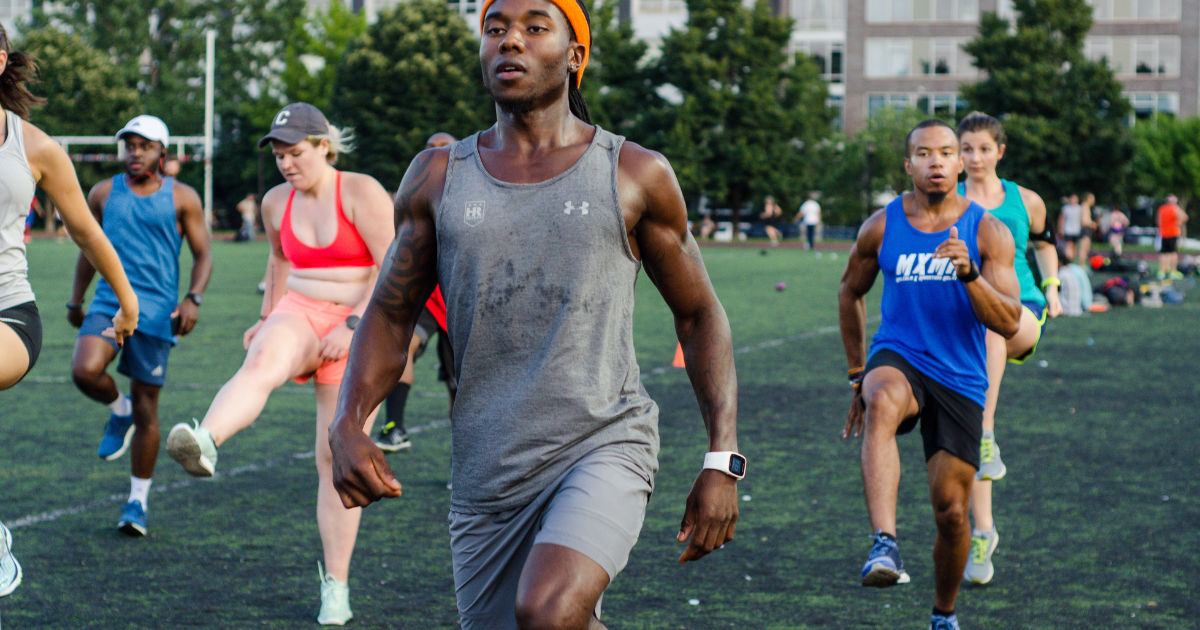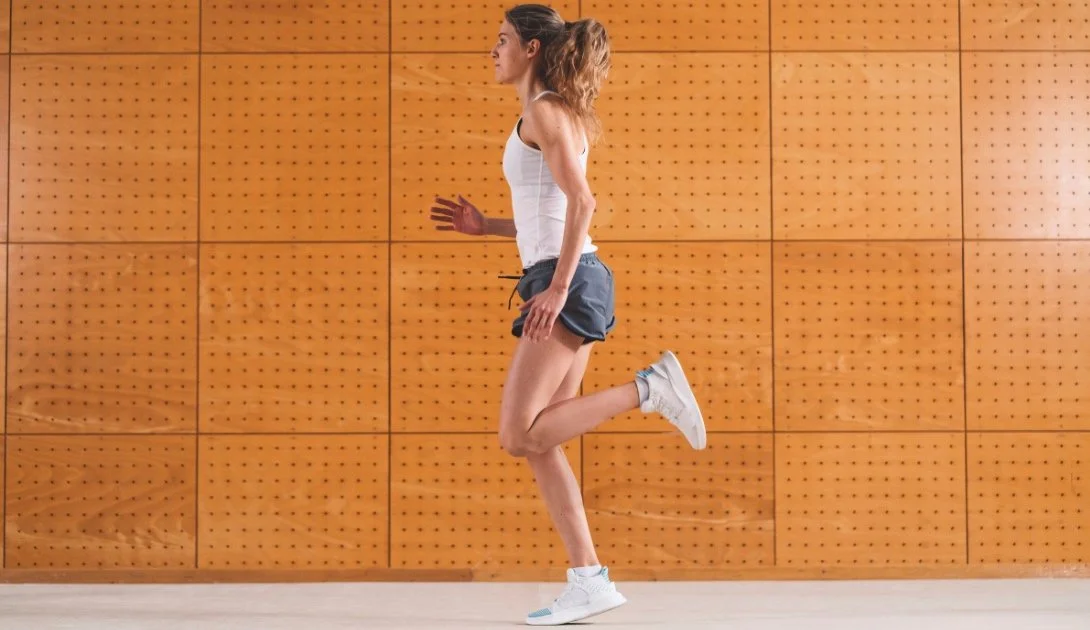Best Dynamic Stretches for Runners
Photo by Marques Jackson Photography at Runstreet Track Tuesdays.
By Marnie Kunz,
NASM-certified trainer, USATF- and RRCA-certified running coach
Dynamic stretches for runners help warm up your muscles for running and also serve to stretch the muscles you will use on the run. In contrast with static stretches (which are stationary), dynamic stretches are active movements in which your joints and muscles go through a full range of motion. Dynamic stretches are particularly helpful to do before you do an intense run — a speed workout, race, or long run. Doing these drills, which mimic the motions used in running, will help prepare your body for the run and reduce your chance of injury. Add these dynamic stretches to your running routine to become a better runner.
Related: 10 Best Hip Stretches for Runners
What Are Dynamic Stretches?
According to the National Academy of Sports Medicine, dynamic stretching uses the force production of a muscle and the body's momentum to take a joint through the full available range of motion. In other words, dynamic stretches use movement to bring joints through their full range of motion. This helps to keep your joints flexible and able to move in a full range, which reduces your chance of injuries and improves your athletic performance.
I teach these dynamic stretches for runners to clients that I train. I recommend doing them before speed workouts and encourage runners to do them as drills before races to complete their warm-up. Dynamic stretches are important to do before track workouts to fire up the muscles that you will use on the run and prevent muscle tears from jumping into speed work cold. You can also do these dynamic types of stretches to warm up before running in the cold.
These dynamic stretches can also be used to improve your running form. Dynamic stretches are also a great way to warm up inside before running in the cold.
Benefits of Dynamic Stretches
There are many benefits of dynamic stretching. Doing dynamic stretches before your run helps improve your flexibility, warm you up, and will help improve your running form, performance, and speed.
As I mentioned, dynamic stretches for runners are great to do before speed workouts or races, as they prepare the muscles that you’ll be using the most in your running. In fact, dynamic stretches are more beneficial than doing just a slow jog to warm up before a race or run. (Ideally, you can do a slow jog and dynamic stretches but if you can only do one, go with dynamic stretches before a race).
Best Dynamic Stretches for Runners
The best dynamic stretches for runners activate the muscles you use while running. These dynamic stretches are also great running drills that you can do to improve your running form. They all activate major muscle groups in your lower body while getting your heart rate up to prepare for the workout.
The key dynamic stretches I teach for runners are butt kicks, high knees, and A-skips. These are all relatively simple movements to do and are easy for beginners and all levels of runners.
Getting Started
To do these dynamic stretches, you can use a track, road, sidewalk, or flat trail, or you can even do them in place if you are constrained for space or if you’re warming up inside. You can do them inside before going out for a cold-weather run, or if you’re working out in the gym before hopping on the treadmill.
When To Warm Up
Before a race, do these dynamic stretches on your way to the start line. If you have a long wait in your race corral before the start gun goes off, you can also do the stretches in place, which is very convenient to keep your body warmed up.
Butt kicks.
You should do these dynamic stretches as close as possible to the start of your race or workout. You do not want to do the stretches too early and then have more than a 10 minute lag before running because your body will cool off and lose the benefits of warming up.
The shorter your race or workout distance, the more important your warm-up will be. If you are running a 5K, mile, or intervals workout, it is especially important to warm up well and include these dynamic stretches close to the start of your run.
If you are doing a long run or marathon, you have some leeway with time to warm up at the beginning of your run. In contrast, every second of an interval workout or short race counts if you are trying to get your best time, so you need to be warmed up before you begin.
Here are the dynamic stretches to include in your run warm up:
Butt Kicks
Targets: Quads, hamstrings, hip flexors
Butt kicks help activate your quad muscles (the front of your upper legs), hamstrings (back of upper legs), and hip flexors, all of which you use for running. Butt kicks are also relatively easy to do and you can do them anywhere — near the race start line or on the track before a speed workout. You can do them moving forward during a slow jog, or you can do them in place if you are limited in space or at the start of a race.
How To Do It:
Begin from a standing starting position with your feet shoulder-width apart. Bend your left knee and raise your left leg and heel up toward your butt. Then switch to bend your right knee and raise your right leg up in a jogging motion.
After the first few butt kicks, you can pick up your heels a little faster and continue bringing each heel up toward your butt. You can do these in place or move forward slowly as you do them.
Do at least 10-12 butt kicks on each side. Butt kicks help warm up your hamstrings, and offer a great calf stretch and quadriceps stretch.
High Knees
Targets: Glutes, hip flexors, hamstrings
High knees engage your glutes, hip flexors, and hamstrings. These dynamic stretches are great to prepare your body for running fast, which uses the same muscles — your glutes, hamstrings, and hip flexors.
Runners have notoriously tight hips so warming up your hip flexors will help prevent tightening up and limited joint range as you run.
How To Do It:
Stand with your head looking forward and chest up and core engaged, with your torso straight up.
Jog in place or jog forward, and bring your knees up to waist level quickly. Alternate knees and swing your left arm and right arm to do arm swings for balance as you skip.
Do high knees for 30 seconds.
A-Skips
Targets: Glutes, calves
A-Skips. Photo by Marques Jackson Photography.
A-Skips are another dynamic stretch that helps your running muscles activate for action. A-skips are also fun, reminiscent of skipping as a kid! They improve your mobility and reduce your risk of injury.
How to Do It:
Start from a standing position.
Skip, exaggerating your skips so you soar slightly higher than regular skips. Alternate hopping up from your right foot and then your left foot in a fluid movement. Also, swing your arms at the same time. Adding the arm swing will help stretch your shoulders as well as help you balance.
Skip for 3o seconds.
Leg swings.
Leg Swings
Targets: Hip flexors, hamstrings, quads, calves
Leg swings are a great way to warm up and stretch your hip muscles, which are often tight in runners. They also stretch your leg muscles. Here’s how to do them:
Front-to-Back Leg Swings:
Stand facing a wall or tree with your hands on the wall for support.
Swing one leg forward until it is parallel to the ground.
Swing the leg back behind you until it is parallel to the ground.
Repeat to do 10-20 leg swings.
Switch legs and repeat the movement on the other side.
Side-to-Side Leg Swings:
Stand with your feet hip-width apart.
Swing one leg to the side until it is parallel to the ground.
Swing the leg back to the center.
Repeat to do 10-20 leg swings.
Switch legs and repeat the movement on the other side.
For a thorough warm-up, do all three of these dynamic stretches at least twice. Check out our Top 5 Stretches for Runners for great static stretches to do after your run to complete your workout.
Have you tried dynamic stretching? Tag me on your running posts - I’m @Runstreet on Instagram - to share your top stretches and get cheered on in your workouts.
Happy running to you!😊
Related Posts: Top 5 Stretches for Runners, 3 Speed Workouts You Can Do Anywhere
Marnie Kunz is a NASM-certified trainer and USATF- and RRCA-certified running coach based in Brooklyn, NY. Marnie likes helping people get and stay active to enjoy a better quality of life. When she’s not doing fitness things, Marnie enjoys exploring with her dog, a mischievous rescue Akita.






